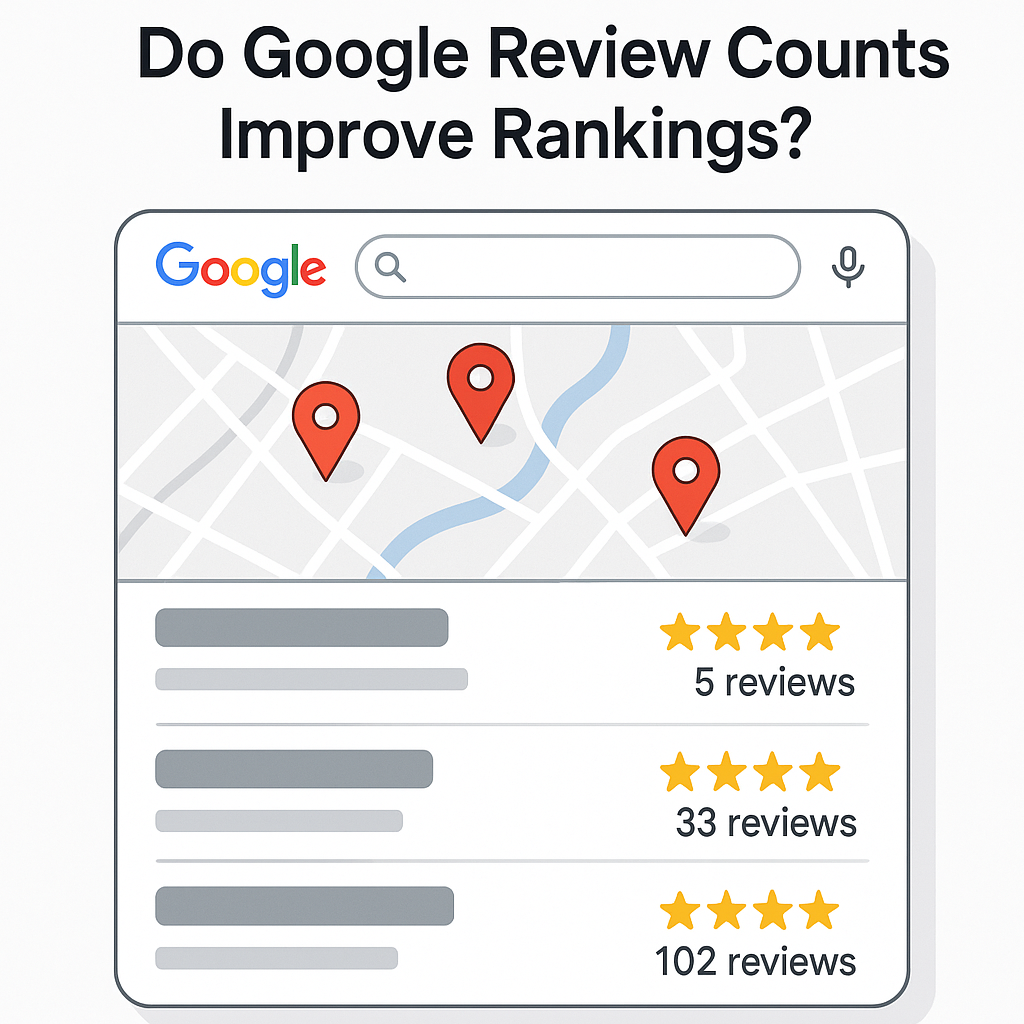
It’s widely assumed that the more Google reviews a business has, the higher it will rank in local search. But recent data from a Sterling Sky case study challenges that belief — and offers a more precise view of how reviews actually influence local visibility.
If you’re focused on improving your local SEO, here’s what you need to know about the role of review volume, and what actions will genuinely move the needle.
Review Count Alone Does Not Improve Rankings
Sterling Sky conducted a controlled test comparing three dentists in the same city:
- One had 19 Google reviews
- Another had 33
- The third had 102
Despite the wide range in review volume, all three businesses ranked similarly in the local pack for relevant keywords.
The takeaway: once you’ve passed a baseline, adding more reviews doesn’t provide a ranking advantage. The Google local algorithm doesn’t reward raw volume beyond a certain point.
Why Getting to 10 Reviews Still Matters
While more reviews don’t directly boost rankings after a certain level, having fewer than 10 reviews can hurt your visibility.
Joy Hawkins notes in the study that businesses under this threshold often rank lower in local search. This isn’t because of the number itself, but because low review volume can signal a lack of trust, activity, or relevance to Google’s algorithm — especially for new or under-optimized listings.
Action step:
If your business has fewer than 10 reviews, prioritize reaching that milestone as soon as possible. It functions like a minimum credibility threshold.
What Google Actually Looks For in Reviews
Instead of total count, Google places more weight on what your customers say and when they say it.
1. Review Content
Google’s algorithm scans the text of reviews to understand the services you offer. A review that says “I went in for emergency tooth extraction” provides far more value than one that says “Great service!”
What to do:
Encourage reviewers to mention specific services or experiences. Avoid scripting, but prompt with context like:
“Feel free to include what service you came in for and how it helped.”
2. Review Recency
Recent reviews show that your business is active and serving customers. A steady stream of new reviews supports ongoing relevance in Google’s eyes.
What to do:
Build review requests into your routine — immediately after a purchase, appointment, or completed service. Aim for consistency, not spikes.
3. User Behavior Signals
While review count doesn’t directly move rankings, it can influence click-through rates. A listing with 100 reviews may appear more trustworthy than one with 5, even if both rank equally. Higher engagement can lead to more conversions — and that user behavior could indirectly influence rankings over time.
What to do:
Don’t just get reviews — ensure your profile converts. Use strong photos, service details, and a clear business description to take advantage of the trust reviews create.
Don’t Game the System — It Will Backfire
Some businesses still try to speed things up with fake reviews or incentives. That approach is short-sighted.
Google’s review spam filters have become increasingly sophisticated. Suspicious behavior — such as a sudden influx of five-star reviews or identical phrasing — can result in reviews being removed or even profile penalties.
What to do:
Solicit only genuine reviews from real customers. Never offer discounts, cash, or gifts in exchange for positive feedback. Stick to Google’s review guidelines.
Respond to Reviews — It Matters
While responding doesn’t directly impact rankings, it shows customers (and Google) that you’re engaged and professional. It also keeps your profile active.
What to do:
Respond to every review — positive or negative. Thank customers, address concerns, and reinforce your commitment to service. Keep it short and sincere.
Beyond Reviews: Don’t Neglect Broader Local SEO
Google uses multiple signals to determine local rankings — including reviews, but also:
- Local backlinks
- Business citations (with consistent name, address, and phone number)
- Online mentions of your brand
What to do:
Complement your review strategy with a strong local SEO foundation. That includes building local links, cleaning up directory listings, and earning brand mentions through partnerships or PR.
Review Strategy Summary: What Matters Most
| Priority | Action |
|---|---|
| Reach 10 Reviews | If you’re below this number, your visibility may suffer. Hit this threshold first. |
| Focus on Review Quality | Ask customers to describe their specific experience or service. |
| Stay Consistent | A steady flow of reviews is better than occasional bursts. |
| Don’t Manipulate | Never buy or incentivize reviews. Google will catch on. |
| Engage | Respond to all reviews professionally and promptly. |
| Support with Local SEO | Use reviews as one piece of a broader visibility strategy. |
Final Thought
Review count may look like a vanity metric, but its real value comes from context, consistency, and trust — not just numbers. If your business is focused only on growing the review total, you’re missing the bigger picture.
Instead, use reviews to reinforce credibility, support SEO, and create meaningful engagement with potential customers. That’s what drives visibility — and business growth.
Source: https://www.sterlingsky.ca/number-of-reviews-impact-ranking/
